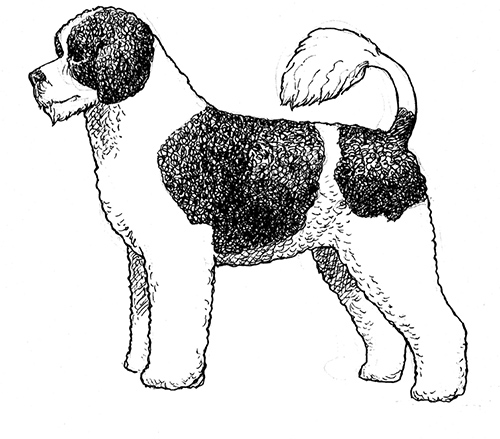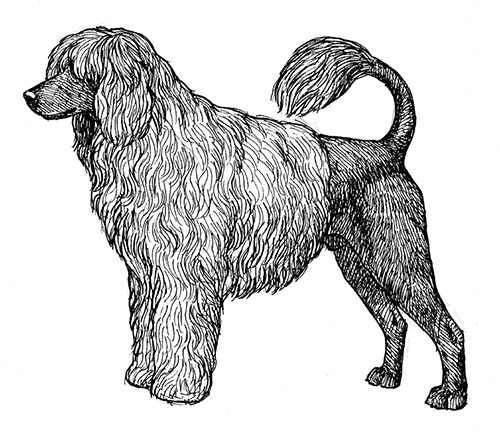Portuguese Water Dog
Gun Dog Group
The goals and purposes of this breed standard include: to furnish guidelines for breeders who wish to maintain the quality of their breed and to improve it; to advance this breed to a state of similarity throughout the world; and to act as a guide for judges.
Breeders and judges have the responsibility to avoid any conditions or exaggerations that are detrimental to the health, welfare, essence and soundness of this breed, and must take the responsibility to see that these are not perpetuated.
Any departure from the following should be considered a fault, and the seriousness with which the fault should be regarded should be in exact proportion to its degree and its effect upon the health and welfare of the dog and on the dog’s ability to perform its traditional work.
History
Curly- and wavy-haired working water dogs have been documented throughout Europe for centuries and are believed to have influenced the development of several breeds of dogs, including the Newfoundland and Chesapeake Bay Retriever. The Portuguese Water Dog has a long history of use in its homeland, where it was, and still is, a vital part of the fishing industry. Prized by their owners, the dogs are primarily used to herd fish into nets. Other duties include taking messages from boat to boat and retrieving escaping fish and lost objects.
The Portuguese Water Dog was recognized by the United Kennel Club in 1987.
General Appearance
The Portuguese Water Dog Is a well-balanced, robust, well-muscled dog of medium build. In proportion, he is slightly longer than tall. Muscular development, resulting from constant swimming, is noticeable. The breed is to be shown in a natural stance, with the front legs positioned so that the feet are slightly forward of the shoulders and the hind legs are positioned approximately under the rump.
Any deviations from the ideal are to be considered faults. Faults are to be penalized to the extent of the deviation and, most importantly, to the extent that the fault would reduce the dog's working ability.
Characteristics
The Portuguese Water Dog is one of exceptional intelligence and trainability, obeying any orders given by its master with willingness and pleasure. It is obedient both to those who care for it and to those for whom it works. It has a spirited disposition, is brave and independent, and resistant to fatigue. Its expression is hard and penetrating. The breed has splendid sight and a fair scenting capability.
Head
The well-proportioned head is strong and wide.
SKULL
When viewed in profile, the skull is slightly longer than the muzzle, and its curvature is more accentuated at the back than in the front. The occiput is well defined. The top of the skull appears to be domed and to have a slight depression in the middle. There is a central furrow in the prominent forehead for two-thirds of the distance between the forehead and the occiput. The stop is well-defined.
MUZZLE
The muzzle is narrower at the nose than at its base. The strong jaws are neither under- nor overshot. The lips are thick, especially in the front.
There is no excess flew. The mucous membranes (including the roof of the mouth, under the tongue, and the gums), are well ticked with black or are quite black in black or white dogs. In brown dogs, color is in harmony with that of the coat. The teeth are not visible when the mouth is closed.
TEETH
A full complement of strong, white teeth meet in a scissors or level bite. The canines are strongly-developed.
EYES
Medium size, round in shape, set well apart. They are brown or black in color. The fine-textured lids have black edges. The dark haws are not apparent. The eyes are never prominent or sunken.
NOSE
The wide, fully-pigmented nose has well-flared nostrils. Nose pigment is black in dogs with black, black and white, or white coats. Brown dogs have nose pigment in harmony with coat color.
EARS
The heart-shaped ears are set well above the line of the eyes, the tips reaching above the lower jaw, not below. Ear leather is fine in texture. The ears are held nicely against the head except for a small opening at the back.
Neck
The straight, short, strongly-muscled, nicely rounded neck is held high. There is no mane and no dewlap.
Forequarters
The well-inclined shoulder is very strongly muscled.
FORELEGS
The straight forelegs are strong. The upper arm is strong. The long forearm is strongly-muscled. The wrist (carpus) is heavy-boned; wider in the front than at the side. The long pasterns are strong. Dewclaws may be removed from the front leg.
Body
The short, level back meets the croup smoothly. The well-formed croup is only slightly inclined. The hip bones are hardly apparent. The wide, deep brisket reaches down at the elbows. The ribs are long and well sprung. There is a good tuck-up.
Hindquarters
The well-curved rump is long, with strongly-muscled buttocks.
HIND LEGS
When viewed from the rear, the thigh bones are parallel and the hind legs are very strongly muscled and straight. The upper thigh and the lower thigh are strongly muscled. The long lower thigh is decidedly inclined from front to back. The hocks are strong; hamstrings are well developed. The rear pasterns are long. Dewclaws are removed from the hind legs.
Feet
The round feel are rather flat, with toes that are not too knuckled up nor too long. The webbing, made up of soft skin reaching to the tip of the toes, is well-covered with hair. The nails are held up slightly off the ground. Black nails are preferred, but white, brown or striped nails, in harmony with coat color, are acceptable. The center pad of the foot is very thick, while the others are normal.
Tail
The tail, which is of great help when swimming and diving, is not docked and has a medium setting. Thick at the base, it tapers down to, but does not reach below, the hock. When at attention, the tail is held in a ring, the front of which should not reach beyond the forward line of the hips.
Coat
The breed is single-coated and has no mane or ruff. The profuse single cost is made up of strong hair that covers the whole body evenly. It is thinner where the forearm meets the brisket and on the groin. There are two acceptable coat types: Wavy and Curly.
The Wavy coat is fairly long and rather loose, with a slight sheen. The hair on the top of the head is upright. The hair on the ears is decidedly longer than the ear leather.
The hair of the Curly coat forms compact cylindrical curls that are thickly planted and are somewhat lusterless. The hair on the top of the head is similar to the hair on the body. The hair on the ears is somewhat wavy.
Two clips are acceptable: Lion Clip and Working Retriever Clip.
LION CLIP
As soon as the hair grows long, the middle part, hindquarters and muzzle are clipped. The hair at the end of the tail is left at full length.
WORKING RETRIEVER CLIP
This clip gives a more natural appearance as well as a smooth, unbroken line. The entire coat is scissored or clipped, following the outline of the dog. A short blanket of coat, no longer than one inch in length, is left. That hair at the end of the tail is left at full length.
Color
Acceptable coat colors include: black; white; various shades of brown; and combinations of black or brown with white. The nose, mouth and eyelid pigment must be black in a white dog. The skin is decidedly bluish in dogs with black, white, or black and white coats.
Height & Weight
Height ranges are as follows: males, between 20 and 23 inches; bitches, between 17 and 21 inches.
Weight ranges are as follows: males, between 42 and 60 pounds; bitches, between 35 and 50 pounds.
Gait
At a walk, steps are short and lively. At a trot, movement is well balanced and forward striding.
Disqualifications
(A dog with a Disqualification must not be considered for placement in a conformation event, and must be reported to UKC.)
Unilateral or bilateral cryptorchid.
Viciousness or extreme shyness.
Albinism.

Curly Coated Retriever Clip

Wavy Coat Lion Clip
Looking for a Dog?
Find a dog that will fit your family.
Note: The breeders on this list are not endorsed by UKC.
Revised January 1, 2007
©Copyright 1987, United Kennel Club
